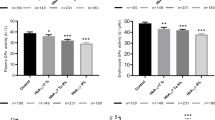Abstract
Cardiovascular complications are the major cause of morbidity and mortality in diabetic patients. An attempt has been made to evaluate the risk factors for coronary heart disease in type II diabetics. In the present study the levels of fasting and postprandial plasma glucose, total cholesterol, low density lipoproteins, triglycerides were high and the levels of high density lipoproteins were low in the type II diabetics compared to controls. The markers of free radical induced injury i.e. malondialdehyde and nitrite/nitrate were high while total antioxidant status a marker for antioxidant protection against reactive oxygen species was low in diabetics compared to controls. The study therefore suggests the importance of assessing these markers of oxidative stress and antioxidant capacity along with the other routine investigations in diabetic patients for initiating antioxidant therapy in addition to primary and secondary preventive measures to mitigate the devastating consequences of diabetes leading to coronary heart disease.
Similar content being viewed by others
References
King, H., Aubert, R.E., Herman, W.H. (1998) Global burden of diabetes, 1995–2025. Prevalence, numerical estimates and projection. Diabetes Care. 21, 1414–1431.
Ramachandran, A., Snehalatha, C., Viswanathan, V. (2002) Burden of type 2 Diabetes and its complications—The Indian Scenario. Curr. Sci. 83, 1471–1476.
Deepa, R, Arvind, K. and Mohan, V. (2002) Diabetes and risk factors for coronary artery disease. Curr. Sci. 83 (12), 1497–1505.
Dincer, Y., Akcay, T., Aldemir, Z. and Likova, H. (2002) Effect of oxidative stress on glutathione pathway in red blood cells from patients with insulin-dependent diabetes mellitus. Met. 51, 1360–1362.
Maritim, A.C., Sanders, R.A. and Watkins, J.B. (2003) Diabetes, Oxidative stress, and antioxidants A review. J. Biochem. Mol. Toxicol. 17, 24–38.
Jialal, I., Devaraj, S. and Venugopal, S.K. (2002) Oxidative stress, inflammation and diabetic vasculopathies: The role of alpha tocopherol therapy. Free radic. Res. 36, 1331–1336.
Ceriello, A., Bortolotti, N., Crescentini, A., Motz, E., Lizzio, S. and Russo, A. (1998) Antioxidant defences are reduced during the oral glucose tolerance test in normal and non-insulin-dependent diabetic subjects. Eur. J. Clin. Invest. 28, 329–333.
Gavino, V.C., Miller, J.S., Ikharebha, S.O., Milo, G.E. and Cornwall, D.G. (1981) Effects of polyunsaturated fatty acids and antioxidants on lipid peroxidation in tissue cultures. J. Lipid Res. 22, 763–769.
Lepoivre, M., Chenal, B., Vapo, A., Lamair, G., Thalander, L. and Tenu, J.P. (1990) Alteration of ribonucleotide reductase activity following induction of nitrite generating pathway in adenocarcinoma cells. J. Biolchemo. 265, 14143–14149.
Re, R., Pellegrini, R.R.N., Proteggente, A., Pannala, A., Yang, M. and Evans, C.R. (1999) Antioxidant activity applying an improved ABTS radical cation decolorization assay. Free radical Biol. and Med. 26, 1231–1237.
Ajay, K. (2001) Coronary Artery Disease and Diabetes. Cardiology Today 4, 221–224.
Saxena, K.K. (2002) Congestive Heart Failure in Diabetes. Cardiology Today 2, 71–76.
Feldman, E.L. (2000) Oxidative stress and diabetic nephropathy: a new understanding of an old problem. J. Clin. Invest. 111, 431–433.
Bonora, E. and Muggeo, M. (2001) Post prandial blood glucose risk factor for cardiovascular disease in Type II diabetes; the epidemiological evidence. Diabetologia 44, 2107–2114.
Castelli, W.P. (1988) Cholesterol and lipids in the risk of coronary artery disease. The Framingham heart study. Can. J. Cardiol. 4, 5–10.
Gopinath, N., Chada, S.C., Sehgal, A., Shekhaw, S. and Tandon, R. (1994) What is desirable lipid profile. Ind. heart J. 46, 325–327.
McKeique, P.M., Miller, G.J. and Marmol, M.G. (1989) Coronary heart disease in South Asian overseas. A review. J. Clin. Epidemiol. 42, 597–601.
Uzel, N., Sivas, A., Uysal, M. and O, Z.H. (1987) Erythrocyte lipid peroxidation and glutathione peroxidase activities in patients with diabetes mellitus. Horm. metab. Res. 19, 89–90.
Gallou, G., Ruelland, A., Legras, B., Maugendre, D., Allannic, H. and Cloarec, L. (1993) Plasma malondialdehyde in type I and type II diabetic patients. Clin. Chem. Acta. 214, 227–234.
Aydin, A., Orhan, H., Sayal, A., Ozata, M., Sahin, G. and Isimer, A. (2001) Oxidative stress and nitric oxide related parameters in type II diabetes mellitus: effects of glycemic control. Clin. Biol. Chem. 34, 65–70.
Seghrouchni, I., Dral, J. and Bannier, E. (2002) Oxidative stress parameters in type I, type II and insulin treated type II diabetes mellitus; insulin treatment efficiency. Clin. Chem. Acta. 321, 89–96.
Leeuwenberg, C., Hardy, M.M., Hazen, L.S., Wagner, P., Ishi, O.S., Steinbrecher, U.P. and Heineck, Jay W. (1997) Reactive nitrogen intermediates promote low density lipoprotein oxidation in human atherosclerotic intima. J. Bio. Chem. 272, 1433–1436.
Chiou, S.H., Chang, C.J., Chou, C.K., Hsu, W.M., Liu, J.H. and Chain, C.H. (1999) Increased nitric oxide levels in aqueous humor of diabetic patients with new vascular glaucoma. Diabetes Care. 22, 861–862.
Kaneto, H., Kajimoto, Y., Miyagawa, J., Matsuoka, T., Fujitani, Y., Umayahara, Y., Hanafusa, T., Matsuzawa, Y., Yamasaki, Y. and Hori, M. (1999) Beneficial Effects of Antioxidants in Diabetes. Diabetes 48, 2398–2406.
Maxwell, S.R. (1995) Prospects for the use of antioxidant therapies. Drugs 49, 345–361.
Maxwell, S.R., Thomason, H., Sandler, D., Leguen, C., Baxter, M.A., Thorpe, G.H., Jones, A.F. and Barnett, A.H. (1997) Antioxidant status in patients with uncomplicated insulin-dependent and non-insulin-dependent diabetes mellitus. Eur. J. Clin. Invest. 27, 484–490.
Pinzani, P., Petruzzi, E., Orlando, C., Gallai, R., Serio, M. and Pazzagli, M. (1998) Serum antioxidant capacity in healthy and diabetic subjects as determined by enhanced chemiluminiscence. J. Biolumin. Chemilumin. 13, 321–325.
Author information
Authors and Affiliations
Corresponding author
Rights and permissions
About this article
Cite this article
Rani, H.S., Madhavi, G., Rao, V.R. et al. Risk factors for coronary heart disease in type II diabetes mellitus. Indian J Clin Biochem 20, 75–80 (2005). https://doi.org/10.1007/BF02867404
Issue Date:
DOI: https://doi.org/10.1007/BF02867404



